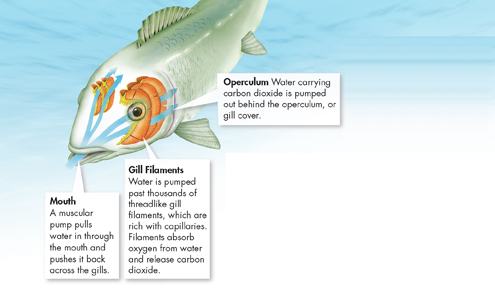
FIGURE 27–6 Respiration With Gills Many aquatic animals, such as fishes, respire with gills, which are thin, selectively permeable membranes. As water passes over the gills, gas exchange is completed within the gill capillaries.
dRespiratory Surfaces of Aquatic Animals
 How do aquatic animals breathe?
How do aquatic animals breathe?
Some aquatic invertebrates, such as cnidarians and some flatworms, are relatively small and have thin-walled bodies whose outer surfaces are always wet. These animals rely on diffusion of oxygen and carbon dioxide through their outer body covering. A few aquatic chordates, including lancelets, some amphibians, and even some sea snakes, rely to varying extents on gas exchange by diffusion across body surfaces.
For large, active animals, however, skin respiration alone is insufficient.  Many aquatic invertebrates and most aquatic chordates other than reptiles and mammals exchange gases through gills. As shown in Figure 27–6, gills are feathery structures that expose a large surface area of thin, selectively permeable membrane to water. Inside gill membranes is a network of tiny, thin-walled blood vessels called capillaries. Many animals, including aquatic mollusks and fishes, actively pump water over their gills as blood flows through inside. This helps maintain differences in oxygen and carbon dioxide concentration that promote diffusion.
Many aquatic invertebrates and most aquatic chordates other than reptiles and mammals exchange gases through gills. As shown in Figure 27–6, gills are feathery structures that expose a large surface area of thin, selectively permeable membrane to water. Inside gill membranes is a network of tiny, thin-walled blood vessels called capillaries. Many animals, including aquatic mollusks and fishes, actively pump water over their gills as blood flows through inside. This helps maintain differences in oxygen and carbon dioxide concentration that promote diffusion.  Aquatic reptiles and aquatic mammals, such as whales, breathe with lungs and must hold their breath underwater. Lungs are organs that exchange oxygen and carbon dioxide between blood and air. You will learn more about lungs shortly.
Aquatic reptiles and aquatic mammals, such as whales, breathe with lungs and must hold their breath underwater. Lungs are organs that exchange oxygen and carbon dioxide between blood and air. You will learn more about lungs shortly.
Quick Lab
GUIDED INQUIRY
Breathing in Clams and Crayfishes

Do not touch the clam or crayfish. Put a drop of food coloring in the water near a clam's siphons. Observe what happens to the coloring.
Put a drop of food coloring in the water near the middle of a crayfish. trong> Keep your fingers away from the crayfish's pincers. Observe what happens to the coloring.
Observe Describe what happened to the coloring in step 1. How does water move through a clam's gills?
Infer What is the clam's main defense? How is the location of the clam's siphons related to this defense?
Compare and Contrast What happened in step 2? Compare the flow of water through the gills of clams and crayfishes.
Infer Unlike many other arthropods, crayfishes have gills. Why do crayfishes need gills?
Analyze and Conclude
Table of Contents
- Formulas and Equations
- Applying Formulas and Equations
- Mean, Median, and Mode
- Estimation
- Using Measurements in Calculations
- Effects of Measurement Errors
- Accuracy
- Precision
- Comparing Accuracy and Precision
- Significant Figures
- Calculating With Significant Figures
- Scientific Notation
- Calculating With Scientific Notation
- Dimensional Analysis
- Applying Dimensional Analysis




